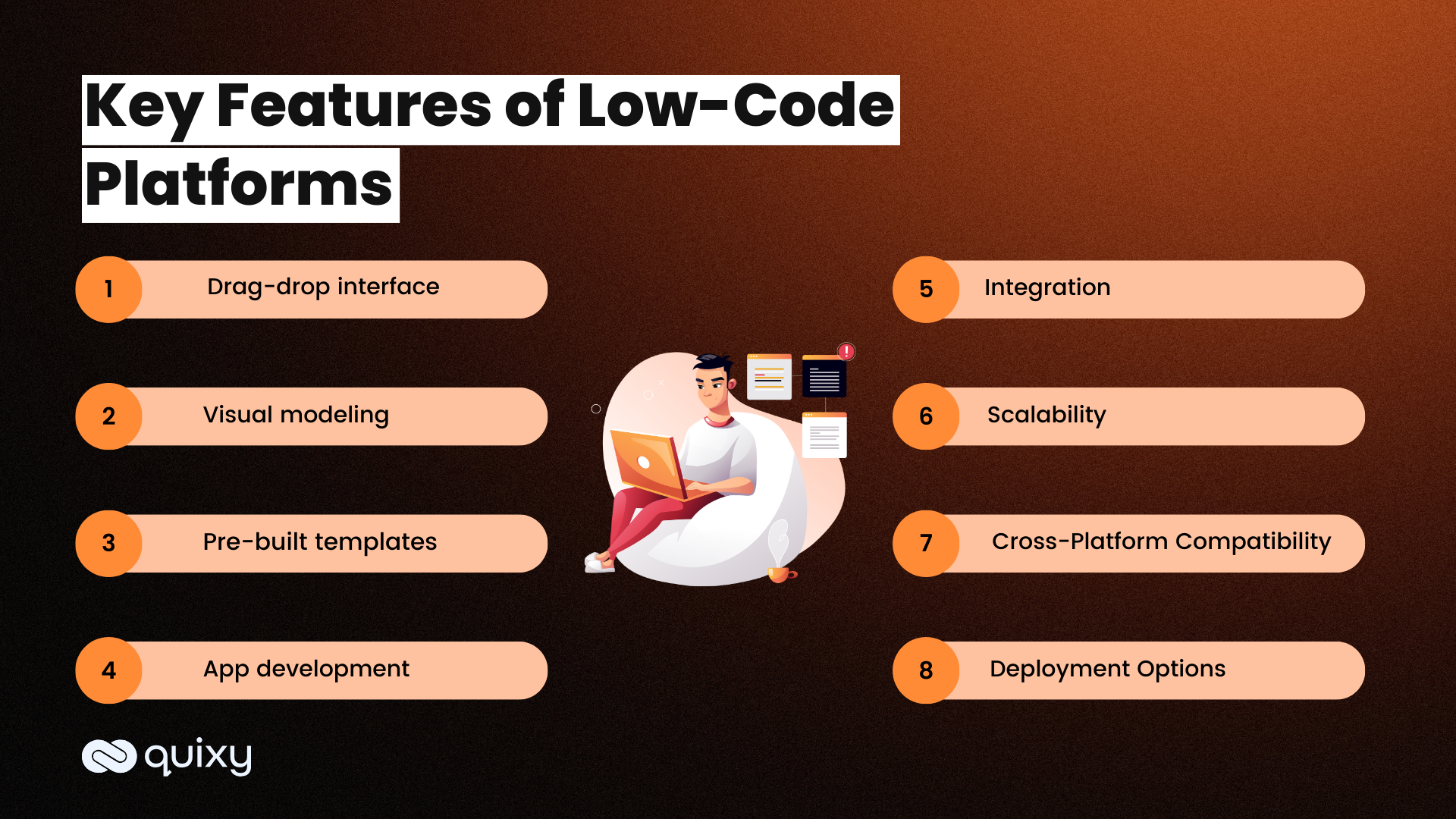
Are you an IT manager looking to invest in a low-code development platform? Are you struggling to find the right tool for your business? Are you afraid of investing in the wrong tool? If your answer is a clear yes, we suggest evaluating the features of low-code development platforms.
Low code development platform features will help you understand the tool’s functionalities. They will also give you understanding of whether a particular tool can fulfill your requirements.
To help you conclude, we have highlighted the top five features of low-code development platforms. Not only that, we have also elaborated on each of the feature’s benefits so that you know how useful they are to you.
Key Features of Low-Code Platform

1. Drag-and-drop interface
The Drag-and-Drop Interface is a prominent feature in low-code development software that simplifies the application creation process. It allows users with limited coding experience to design and build applications by dragging and dropping pre-built components and elements onto a visual canvas. These components might include buttons, forms, databases, and more.
Here’s why this feature is so significant:
Easy and intuitive design process
The drag-and-drop interface makes the entire design process remarkably user-friendly and intuitive. Instead of having to write lines of code to create user interfaces or functional elements, users or citizen developers can visually arrange and connect components like building blocks. This simplicity means that citizen developers with varying levels of technical expertise, including students and business users, can participate in the application development process. This democratization of development empowers a broader range of people to contribute to software creation.
Accelerated development speed
The drag-and-drop interface significantly accelerates the development speed by eliminating the need for extensive manual coding. This is paramount in today’s fast-paced commerce landscape, where time-to-market can be a critical factor in a product’s success. With this feature, developers can build and iterate on applications much more quickly, giving businesses a competitive edge by allowing them to respond rapidly to changing market demands.
Also Read: Quixy announces Snap2App Feature for its Platform Users
Enhanced productivity
Developers can work more efficiently by simplifying the application development process and providing a visual canvas for designing user interfaces and workflows. They can allocate more time to crafting high-level logic and business functionality rather than getting bogged down in the intricacies of coding. This streamlined approach accelerates project delivery, reduces development cycles, and allows teams to quickly respond to changing business needs.
2. Visual modeling
Visual modeling enables users to design applications through graphical representations rather than traditional coding. Users create visual models by dragging and dropping elements like data tables, user interface components, and logic flowcharts onto a canvas. These models visually depict the application’s structure, data relationships, and workflow, making it easier to conceptualize and design complex systems.
Here’s why visual modeling is so essential:
Graphical representation of workflows
Visual modeling enables developers to represent the entire application workflow visually. Instead of deciphering lines of complex code, users can design and understand how different processes and functions within the application interact through visual diagrams and flowcharts. This approach simplifies the planning and communication of the application’s logic, making it easier for developers and stakeholders, including commerce students, to collaborate effectively. It also facilitates rapid prototyping and adjustments, ensuring that the final product aligns with the desired functionality.
Also Read: How to Choose Low-Code Platform?
Simplified data integration
Visual modeling allows developers to map out processes & how data from various sources, such as databases, APIs, or external systems, will be integrated into the application. This simplifies what can be a complex and error-prone process in traditional coding. Visual models make identifying data mapping, transformation, and validation requirements easier, ensuring that the application effectively retrieves, processes, and displays data from diverse sources.
Enhanced collaboration
Visual modeling fosters collaboration between technical and non-technical stakeholders. Business analysts, designers, and developers can work together on the same visual representations, ensuring everyone’s understanding of the project’s goals and requirements. This collaborative approach results in better alignment between IT and business teams.
3. Pre-built components and templates
The pre-built components and templates feature in low-code development software offers a library of ready-made building blocks and design templates that users can readily incorporate into their applications. These components encompass user interface elements (like buttons, forms, and menus), backend functionalities (such as database connectors or authentication modules), and entire application templates for specific use cases (e.g., project management or e-commerce).
Here’s why visual modeling is so essential:
Accelerated development
Pre-built components and templates significantly expedite the application development process. Developers can quickly integrate well-tested and commonly used functionalities, reducing the time required for coding and debugging. This also minimizes the risk of coding errors and security vulnerabilities, resulting in more robust and secure applications.
Consistency
By using standardized components and templates, developers ensure consistency in the user interface and functionality across the application. This consistency enhances the user experience and maintains a professional and cohesive look and feel.
Streamlined maintenance
Applications built with pre-built components are easier to maintain. When updates or changes are needed, developers can apply them globally by modifying the component or template, saving time and effort in ongoing maintenance and updates.
Also Read: Low-Code or No-Code Which Solution Best Fits Your Needs?
4. Mobile app development capabilities
Mobile app development capabilities empower users to create mobile applications efficiently with minimal coding expertise. It provides a set of tools, templates, and pre-built components optimized for mobile platforms (iOS and Android). Users can design, develop, and deploy cross-platform or native mobile apps, complete with responsive layouts, touch-friendly interfaces, and device-specific functionalities.
Here’s why mobile app development capabilities are so essential:
Cross-platform compatibility
With the rise of diverse mobile devices and operating systems, the demand for cross-platform compatibility has surged. Low-code platforms excel in this regard by allowing developers to create applications that run seamlessly on multiple platforms, such as iOS and Android, using a single codebase. This not only saves developers from the daunting task of coding separate apps for each platform but also ensures a consistent user experience across various devices.
Responsive design options
A top low-code platform offers a range of responsive design options that automatically adapt the application’s layout and user interface to different screen sizes and orientations. This responsiveness is essential for providing users with an optimal viewing experience, whether they’re using a smartphone, tablet, or desktop computer. It also simplifies the development process by eliminating the need to create separate layouts for each device type.
Increased accessibility
By lowering the technical barriers to entry, this feature enables a broader range of individuals within an organization to participate in mobile app development. Business analysts, designers, and subject matter experts can contribute to the creation and enhancement of mobile apps, fostering collaboration and innovation across teams.
5. Integration with external systems
Integrating external systems functionality in low-code development software allows applications to connect seamlessly with external data sources, services, and systems. It provides a set of tools and connectors that simplify the process of integrating with databases, APIs, legacy systems, and third-party services. This capability enables developers to leverage existing data and functionalities, extending the capabilities of their applications. It also promotes interoperability between different software systems, enhancing data sharing and automation.
Here’s why integration capability is essential:
Seamless connectivity with APIs
Application Programming Interfaces (APIs) serve as the gateways to external data and services. A top low-code platform provides developers with intuitive tools to connect their applications to APIs seamlessly. This means that developers can effortlessly tap into a wealth of services, from payment gateways to social media platforms, without complex coding. This level of connectivity not only enhances the functionality of the applications but also expands their scope and usefulness.
Easy data exchange with other software
A robust low-code platform enables applications to send and receive data from various sources, facilitating processes like data synchronization, data import/export, and real-time updates. For businesses, this means that their applications can operate in harmony with existing software infrastructure, promoting efficiency and data consistency.
Future-proofing
As business needs evolve, the ability to integrate with external systems ensures applications remain adaptable. Organizations can easily incorporate new technologies, services, or data sources into their software ecosystems, keeping their solutions relevant and up-to-date.
6. Scalability
Scalability in low-code development means that applications can grow and adapt to handle increased workloads and user demands. Low-code platforms provide the infrastructure and tools to ensure that applications can scale seamlessly as businesses expand. This scalability is essential for accommodating growth without the need for extensive redevelopment, ultimately saving time and resources.

7. Cross-Platform Compatibility
Low-code platforms support cross-platform compatibility, allowing applications to run on various operating systems, devices, and browsers. This capability ensures that applications are accessible to a wide range of users, irrespective of the devices they use. Cross-platform compatibility simplifies application deployment and provides a consistent user experience, contributing to broader accessibility and user satisfaction.
8. Deployment Options
Low-code platforms offer flexible deployment options, allowing organizations to choose how and where their applications are hosted. Whether it’s on-premises, in the cloud, or in hybrid environments, low-code platforms provide a range of deployment choices to suit specific business needs. This flexibility enables organizations to align application deployment with their infrastructure and security preferences, ensuring optimal performance and accessibility.
Also Read: How Low-Code Empowers Citizen Developers?
Benefits of using a top low-code platform
The benefits of using a top low-code platform encompass faster development, cost-effectiveness, reduced reliance on IT teams, rapid prototyping and deployment, and flexibility and scalability. These advantages are invaluable for businesses seeking to innovate and thrive in the competitive landscape and for individuals, including students and aspiring developers, looking to streamline the software development process and bring their ideas to life more efficiently.
Faster development
Low-code development platforms significantly speed up application creation. Access to pre-built templates, components, and drag-and-drop interfaces reduces the need for extensive coding. This acceleration translates to faster time-to-market for software projects, helping organizations respond quickly to changing business requirements and competitive pressures.
Cost-effectiveness
Low-code development platforms drive cost efficiency by reducing the need for extensive developer teams, streamlining development processes, enabling component reuse, and offering performance optimization tools. These factors collectively lead to lower upfront and long-term expenses for organizations using these platforms.
Reduced reliance on IT teams
Low-code platforms empower business users and citizen developers to create applications without constantly relying on IT teams for every small change or addition. This decentralization of development responsibilities frees up IT teams to focus on more strategic tasks, such as enhancing the overall IT infrastructure and addressing critical issues, ultimately boosting the efficiency of the entire organization.
Rapid prototyping and deployment
With visual modeling and pre-built components, developers can create prototypes and proof-of-concept applications in a fraction of the time it would take with traditional development methods. This agility allows businesses to test ideas and gather feedback from stakeholders and end-users more rapidly. Once an application is ready, low-code platforms simplify the deployment process, ensuring that applications can go live quickly.
Flexibility and scalability
Low-code platforms can be used to create a wide range of applications, from simple mobile apps to complex enterprise solutions. This adaptability ensures that the software infrastructure can evolve with the business, accommodating new requirements and technologies. Besides, they can scale to handle increased user loads, data volumes, and functionality demands. This scalability ensures that the software can continue to support the organization’s growth without significant redevelopment efforts.
Conclusion
From the user-friendly drag-and-drop interfaces that empower individuals of diverse technical backgrounds to create applications to the seamless integration with external systems that broadens the horizons of what’s achievable, low-code platforms support innovation and efficiency. They increase productivity, reduce expenses, foster prototyping, and embrace the ever-evolving customer demands. Adopting low code and citizen development will empower you to innovate, adapt, and compete effectively in today’s fast-paced environment. So what are you waiting for? Explore the top low code tool and its features to see the capabilities it has.
Frequently Asked Questions (FAQs)
Q. How does low-code speed up app development?
Low-code expedites app development by offering pre-built components and visual tools. Developers can focus on high-level tasks while the platform handles the coding details, resulting in faster delivery times.
Q. Can we have control over low-code app customization?
Low-code platforms provide extensive customization options, allowing you to tailor the app’s user interface, features, and functionality to align with your specific needs and preferences.
Q. Do I need Coding experience for low-code development?
Low-code platforms are designed for individuals with varying coding experience. They offer user-friendly interfaces, making app development accessible to both experienced developers and those with minimal coding knowledge.
Q. Is low-code app development Secure?
Low-code platforms prioritize security with built-in features like authentication, authorization, and data encryption. This ensures that applications developed with low-code are robust and protected against security threats.
Q. Does low-code development offer an Integration feature?
Low-code platforms support seamless integration with external data sources, including databases and APIs. This capability enables you to incorporate data from various sources into your applications, enhancing their functionality.
Q. Is Scalability a low-code platform feature?
Low-code platforms offer scalability options that allow your applications to grow alongside your business needs. You can easily expand and enhance your apps as your business evolves without major development efforts.
Q. What is Low-code’s role in business-IT collaboration?
Low-code platforms foster collaboration between business and IT teams by providing a common platform where non-technical users and developers can work together. This streamlines communication, accelerates project delivery and ensures that the app aligns with business goals.
Login
Please login to comment
0 Comments
Oldest















